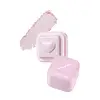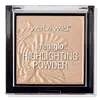What's inside
What's inside
 Key Ingredients
Key Ingredients

 Benefits
Benefits

 Concerns
Concerns

 Ingredients Side-by-side
Ingredients Side-by-side

Mica
Cosmetic ColorantSynthetic Fluorphlogopite
Titanium Dioxide
Cosmetic ColorantCetearyl Ethylhexanoate
EmollientPentylene Glycol
Skin ConditioningTriethoxycaprylylsilane
Silica
AbrasiveGlycerin
HumectantGellan Gum
Squalane
EmollientOctyldodecyl Stearoyl Stearate
EmollientHydrogenated Lecithin
EmulsifyingPolysorbate 80
EmulsifyingCaprylyl Glycol
EmollientGlyceryl Caprylate
EmollientChondrus Crispus Powder
AbrasiveTin Oxide
AbrasiveTocopherol
AntioxidantDisodium EDTA
CI 75470
Cosmetic ColorantMica, Synthetic Fluorphlogopite, Titanium Dioxide, Cetearyl Ethylhexanoate, Pentylene Glycol, Triethoxycaprylylsilane, Silica, Glycerin, Gellan Gum, Squalane, Octyldodecyl Stearoyl Stearate, Hydrogenated Lecithin, Polysorbate 80, Caprylyl Glycol, Glyceryl Caprylate, Chondrus Crispus Powder, Tin Oxide, Tocopherol, Disodium EDTA, CI 75470
Synthetic Fluorphlogopite
Dimethicone
EmollientBoron Nitride
AbsorbentOctyldodecyl Stearoyl Stearate
EmollientTrimethylsiloxysilicate
EmollientNylon-12
Ethyl Macadamiate
Skin ConditioningPolysorbate 20
EmulsifyingPhytosteryl Macadamiate
Skin ConditioningMagnesium Aluminum Silicate
AbsorbentCaprylic/Capric Triglyceride
MaskingPhenoxyethanol
PreservativeSorbitan Stearate
EmulsifyingCaprylyl Glycol
EmollientTin Oxide
AbrasiveHexylene Glycol
EmulsifyingEthylhexylglycerin
Skin ConditioningWater
Skin ConditioningSilica
AbrasiveO-Cymen-5-Ol
AntimicrobialPolyacrylamide
Tocopheryl Acetate
AntioxidantLauroyl Lysine
Skin ConditioningC13-14 Isoparaffin
EmollientLaureth-7
EmulsifyingTriethoxycaprylylsilane
Tocopherol
AntioxidantTitanium Dioxide
Cosmetic ColorantMica
Cosmetic ColorantIron Oxides
CI 77492
Cosmetic ColorantCI 77499
Cosmetic ColorantCI 75470
Cosmetic ColorantCI 77510
Cosmetic ColorantSynthetic Fluorphlogopite, Dimethicone, Boron Nitride, Octyldodecyl Stearoyl Stearate, Trimethylsiloxysilicate, Nylon-12, Ethyl Macadamiate, Polysorbate 20, Phytosteryl Macadamiate, Magnesium Aluminum Silicate, Caprylic/Capric Triglyceride, Phenoxyethanol, Sorbitan Stearate, Caprylyl Glycol, Tin Oxide, Hexylene Glycol, Ethylhexylglycerin, Water, Silica, O-Cymen-5-Ol, Polyacrylamide, Tocopheryl Acetate, Lauroyl Lysine, C13-14 Isoparaffin, Laureth-7, Triethoxycaprylylsilane, Tocopherol, Titanium Dioxide, Mica, Iron Oxides, CI 77492, CI 77499, CI 75470, CI 77510
Ingredients Explained
These ingredients are found in both products.
Ingredients higher up in an ingredient list are typically present in a larger amount.
Caprylyl Glycol is a humectant and emollient, meaning it attracts and preserves moisture.
It is a common ingredient in many products, especially those designed to hydrate skin. The primary benefits are retaining moisture, skin softening, and promoting a healthy skin barrier.
Though Caprylyl Glycol is an alcohol derived from fatty acids, it is not the kind that can dry out skin.
This ingredient is also used as a preservative to extend the life of products. It has slight antimicrobial properties.
Learn more about Caprylyl GlycolCi 75470 is a bright-red pigment. It is AKA carmine.
Carmine is derived from insects such as the cochineal beetle. This ingredient has been used as a natural dye for over 2000 years.
Mica is a naturally occurring mineral used to add shimmer and color in cosmetics. It can also help improve the texture of a product or give it an opaque, white/silver color.
Serecite is the name for very fine but ragged grains of mica.
This ingredient is often coated with metal oxides like titanium dioxide. Trace amounts of heavy metals may be found in mica, but these metals are not harmful in our personal products.
Mica has been used since prehistoric times throughout the world. Ancient Egyptian, Indian, Greek, Roman, Aztec, and Chinese civilizations have used mica.
Learn more about MicaOctyldodecyl Stearoyl Stearate is created from stearic acid.
It is an emollient and thickens the lipid (oil) portion of a product. Due to its emollient properties, it may not be fungal-acne safe.
Silica, also known as silicon dioxide, is a naturally occurring mineral. It is used as a fine, spherical, and porous powder in cosmetics.
Though it has exfoliant properties, the function of silica varies depending on the product.
The unique structure of silica enhances the spreadability and adds smoothness, making it a great texture enhancer.
It is also used as an active carrier, emulsifier, and mattifier due to its ability to absorb excess oil.
In some products, tiny microneedles called spicules are made from silica or hydrolyzed sponge. When you rub them in, they lightly polish away dead skin layers and enhance the penetration of active ingredients.
Learn more about SilicaSynthetic Fluorphlogopite is the synthethic version of mica. It consists of fluorine, aluminum and silicate.
Synthetic Fluorphlogopite is used to add volume to products.
It is considered non-irritating on the skin.
Learn more about Synthetic FluorphlogopiteTin Oxide is an inorganic oxide used to add opacity and volume to a product. In nature, it is already found in mineral form. The main ore of tin is an opaque and shiny mineral called casseterite.
Tin Oxide helps remove translucency in a product, or make it more opaque. Besides adding opacity, tin oxide is used for bulking to add volume.
Titanium dioxide is a mineral UV filter widely used in sunscreens and cosmetics.
It is one of only two UV filters officially classified as “mineral” by regulatory agencies, the other being zinc oxide.
Titanium dioxide provides broad-spectrum protection mostly in the UVB and UVAII range, with some protection in the UVAI range.
While its UVA protection isn’t as strong as zinc oxide’s, the difference is minor.
A common myth is that mineral UV filters reflect UV light. However, modern research shows titanium dioxide absorbs UV radiation like chemical filters (~95% absorption & 5% reflection).
Thanks to its non-irritating nature, titanium dioxide is suitable for sensitive, acne-prone, or redness-prone skin. It is unlikely to cause "eye sting" like other sunscreen ingredients.
A major drawback of this ingredient is its white cast and thick texture. This is why mineral sunscreens often leave a white cast and are less cosmetically elegant than chemical/hybrid sunscreens.
To improve white cast and spreadability, micronized or nano-sized titanium dioxide is often used.
There are ongoing concerns surrounding nano-titanium oxide's impact on marine ecosystems.
There is no conclusive evidence that any form of titanium oxide (or any other sunscreen ingredients) will cause harm to marine ecosystems or coral reefs. The science is still developing but many consumers are keeping a close eye on this issue.
Please note, many destinations have reef-safety sunscreen rules. For instance, the U.S. Virgin Islands advises all visitors to use non-nano mineral sunscreens.
Nano mineral sunscreens once raised safety concerns about absorption into skin.
Extensive research has shown that they do not penetrate healthy or damaged skin; they remain safely on the surface and the top layer of dead skin (stratum corneum).
You'll likely find titanium dioxide bundled with alumina, silica, or dimethicone. These ingredients help make titanium dioxide highly photostable; this prevents it from interacting with other formula components under UV light.
Learn more about Titanium DioxideTocopherol (also known as Vitamin E) is a common antioxidant used to help protect the skin from free-radicals and strengthen the skin barrier. It's also fat soluble - this means our skin is great at absorbing it.
Vitamin E also helps keep your natural skin lipids healthy. Your lipid skin barrier naturally consists of lipids, ceramides, and fatty acids. Vitamin E offers extra protection for your skin’s lipid barrier, keeping your skin healthy and nourished.
Another benefit is a bit of UV protection. Vitamin E helps reduce the damage caused by UVB rays. (It should not replace your sunscreen). Combining it with Vitamin C can decrease sunburned cells and hyperpigmentation after UV exposure.
You might have noticed Vitamin E + C often paired together. This is because it is great at stabilizing Vitamin C. Using the two together helps increase the effectiveness of both ingredients.
There are often claims that Vitamin E can reduce/prevent scarring, but these claims haven't been confirmed by scientific research.
Learn more about TocopherolTriethoxycaprylylsilane is a silicone used to bind and stabilize ingredients.
As an emulsifier, it helps prevent ingredients from separating. This can help elongate the shelf life of products.
Triethoxycaprylylsilane is often used to coat mineral sunscreens ingredients to help give a better feel. It also helps reduce oxidative stress in sunscreens.
Learn more about Triethoxycaprylylsilane